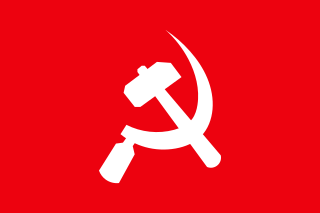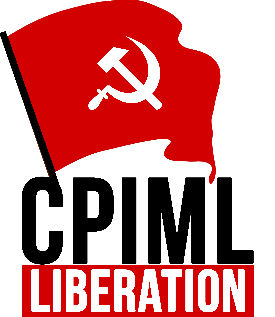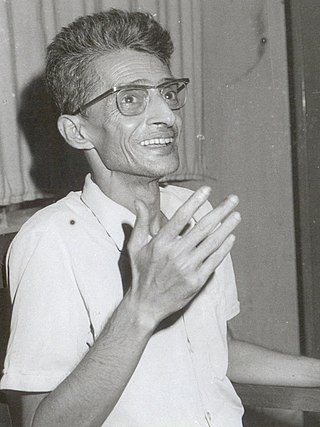
All India Coordination Committee of Communist Revolutionaries was formed in 1967 as a splinter group of Communist Party of India (Marxist), seeing its participation in the United Front government in West Bengal as a betrayal. Initially the group was known as AICCR of the CPI(M), and partially functioned as an inner-party fraction.

The Communist Party of India (Marxist–Leninist) (CPI (ML)) was an Indian communist party formed by the All India Coordination Committee of Communist Revolutionaries (AICCCR) at a congress in Calcutta in 1969. The foundation of the party was declared by Kanu Sanyal at a mass meeting in Calcutta on 22 April, Vladimir Lenin's birthday. Later the CPI(ML) party splintered into several Naxalite groups.

The Communist Party of India (Marxist–Leninist) Liberation is a communist political party in India. The party is represented in Bihar and Jharkhand Legislative Assemblies. Since 2023, the party is also a member of the INDIA electoral alliance. In Bihar, party has significant base amongst the Extremely Backward Castes and the Schedule Castes. It was successful in mobilising Upper Backward Caste group such as Koeris in some districts of central Bihar, prior to the rise of Lalu Prasad Yadav. The party faced existential crisis when a large section of its Koeri and Yadav support base was defected to Rashtriya Janata Dal in 1990s. However, the ideological commitment of its cadre protected it from disintegration. It staged a comeback in politics after winning twelve seats in Bihar Legislative Assembly in 2020 and by sending two of its members to Lok Sabha in 2024 Indian general elections.

Communist Party of India (Marxist-Leninist) is an anti-revisionist Marxist–Leninist communist party in India. After the death of Charu Majumdar in 1972 the Communist Party of India (Marxist-Leninist) pro Charu Majumdar central committee was led by Mahadev Mukherjee and Jagjit Singh Sohal, and the Central Committee took a stand to defend the line of Charu Majumdar on 5–6 December 1972.

Charu Mazumdar, popularly known as CM, was an Indian Communist leader, and founder and General Secretary of the Communist Party of India (Marxist-Leninist). Born into a progressive landlord family in Siliguri in 1918, he became a Communist during the Indian Independence Movement, and later formed the militant Naxalite cause. During this period, he authored the historic accounts of the 1967 Naxalbari uprising. His writings, particularly the Historic Eight Documents, have become part of the ideology of a number of Communism-aligned political parties in India.

Ashim Chatterjee is an Indian politician and a former Naxalite leader. He was a student of the then Presidency College, Kolkata, and leader of firstly Bengal Provincial Student's Federation and then student leader of Communist Party of India (Marxist-Leninist) in Calcutta. Chatterjee broke ranks with Charu Majumdar in 1971 after the failure of the attempts to build an armed movement in the Debra-Gopiballavbur area in West Bengal and due to the opposition of CPI(ML) towards the liberation struggle of Bangladesh. He was imprisoned during 1972–78. Chatterjee formed the Bengal-Bihar-Odisha Border Regional Committee, CPI(ML) as a separate faction. His group joined the CPI(ML) of Satyanarayan Singh. Later Chatterjee formed the Communist Revolutionary League of India.
Kanu Sanyal was an Indian communist politician. In 1967, he was one of the main leaders of the Naxalbari uprising and in 1969 he was one of the founding leaders of Communist Party of India (Marxist-Leninist). Sanyal died by suicide on 23 March 2010.

The Historic Eight Documents are a set of eight monographs authored by the Indian Maoist revolutionary Charu Majumdar that outline the ideological principles on which the Naxalite militant communist movement in India was based. They laid down the idea that the Indian State was a bourgeois institution and that the main Indian communist parties had embraced revisionism by agreeing to operate within the framework of the Constitution of India. They urged a Maoist protracted people's war to overthrow the Indian State. They denounced the Soviet Union both for being revisionist, as well as for supporting the Indian State.

The Naxalite–Maoist insurgency is an ongoing conflict between Maoist groups known as Naxalites or Naxals and the Indian government. The influence zone of the Naxalites is called the red corridor, which has been steadily declining in terms of geographical coverage and number of violent incidents, and in 2021 it was confined to the 25 "most affected" locations, accounting for 85% of Left Wing Extremism (LWE) violence, and 70 "total affected" districts across 10 states in two coal-rich, remote, forested hilly clusters in and around the Dandakaranya-Chhattisgarh-Odisha region and the tri-junction area of Jharkhand, Bihar, and West Bengal. The Naxalites have frequently targeted police and government workers in what they say is a fight for improved land rights and more jobs for neglected agricultural labourers and the poor.
Communist Party of India (Marxist–Leninist) People's War, usually called People's War Group (PWG), was an underground communist party in India. It merged with the Maoist Communist Centre of India to form the Communist Party of India (Maoist) in 2004. Muppala Lakshmana Rao ('Ganapathi') was the general secretary of the party. The ideology of the party was Marxism-Leninism-Maoism.
Vinod Mishra was an Indian communist politician. Mishra served as the General Secretary of the Communist Party of India (Marxist-Leninist) Liberation between 1975 and 1998.
The Central Organising Committee, Communist Party of India (Marxist–Leninist) Party Unity, more commonly known as CPI(ML) Party Unity or simply 'Party Unity', was a communist party in India 1982-1998. Narayan Sanyal alias Naveen Prasad was the general secretary of the party. Party Unity was the official organ of the party. CPI(ML) Party Unity was one of the predecessors of the Communist Party of India (Maoist).
Santosh Rana was an Indian politician. In the 1960s, he was a prominent figure in the armed struggle of the Naxalites led by Charu Majumdar. Rana received Ananda Puraskar for his book Rajnitir Ek Jibon in 2018.
Satyanarayan Singh was an Indian communist politician. Singh was one of the early leaders of the Communist Party of India (Marxist-Leninist), being its secretary in Bihar.
Sushital Ray Chowdhary was an Indian Communist intellectual and founder member of Communist Party of India (Marxist-Leninist). He was the editor of the organs of the CPI, CPI(M) and CPI(ML). He eventually fell out with the mainstream Charu Majumdar group and died of a heart attack in March, 1971.

Saroj Dutta popularly known comrade SD, was an Indian communist intellectual and poet, active in the Naxalite movement in West Bengal in the 1960s. He was the first West Bengal state secretary of Communist Party of India (Marxist-Leninist). He also remained editor-in-chief of the Amrita Bazar Patrika during the 1940s.

The Communist Party of India Red Star was formed in 2009 merging with various factions of CPI (ML), following the Bhopal Special Conference in 2009. with K N Ramachandran as the General Secretary, who has been reelected to the post in the 9th, 10th and 11th Congresses of the Party, which were held in 2011 at Bhubaneswar (Odisha) in 2015 at Lucknow & 2018 at Bengaluru (Karnataka) 5respectively.

Naxalbari uprising was an armed peasant revolt in 1967 in the Naxalbari block of Siliguri subdivision in Darjeeling district, West Bengal, India. It was mainly led by tribals and the radical communist leaders of Bengal and further developed into the Communist Party of India (Marxist–Leninist) in 1969. The armed struggle became an inspiration to the Naxalite movement which rapidly spread from West Bengal to other states of India creating division within the Communist Party of India (Marxist) - India's primary communist party.
Central Organising Committee, Communist Party of India (Marxist–Leninist) was a communist party in India, one of the main splinter factions of the original Communist Party of India (Marxist–Leninist). COC, CPI(ML) occupied a middle position between the pro-Charu Majumdar group led by Mahadev Mukherjee and the anti-Majumdar group led by Satyanarayan Singh. Failing to articulate a common ideological position, COC, CPI(ML) soon suffered internal divisions and splits. Two of the splinter groups of COC, CPI(ML) in Andhra Pradesh are predecessors of the present-day Communist Party of India (Maoist).
Central Organising Committee, Communist Party of India (Marxist–Leninist) Shantipal was an underground political party in India. The Shanti Pal group emerged as through a split in the North Bengal-Bihar Regional Committee of the Communist Party of India (Marxist-Leninist), being the pro-Lin Biao faction. The leader of the faction, Shanti Pal, had been a school teacher in Phansidewa who became a key CPI(ML) leader. After forming his own faction Pal remained loyal to the line of the CPI(ML) leader Charu Majumdar. Pal's party combatted landlords in areas like Godda and Sahebganj. The party opposes participation in elections and calls for armed agrarian revolution.





